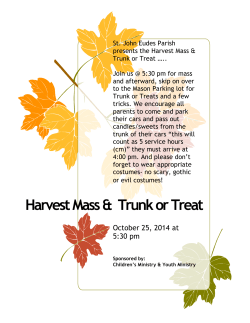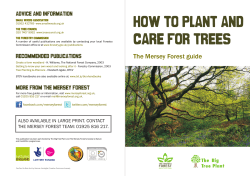
Selecting, Planting and Staking Trees
Selecting, Planting and Staking Trees U.K. Schuch1 and J.J. Kelly2 1Plant Sciences Department and 2Pima County Cooperative Extension, University of Arizona, Tucson, AZ 85721 Why do trees and shrubs fail? ■ Poor production ■ Poor selection ■ Poor timing ■ Poor planting ■ Poor irrigation ■ Poor maintenance ■ Diseases, pests, abiotic stresses Plant Selection • Site analysis – Space above and below ground • Environment – Climate zone – Exposure – Dry/wet locations Plant Selection • Soil – Depth (can root to depth of 36”) – Texture (sand, silt, clay) – Compaction/ drainage – pH (alkalinity/ acidity) – Salinity – Fertility/toxicity Plant Function • Plant size and shape • Shading • Screening Selecting Plants • Average size • Vigorous, healthy shoots Appropriate size canopy with healthy foliage No evidence of insects or disease on leaves and stems No physical damage on leaves and stems Avoid closely staked trees Good taper of trunk Central leader or multiple stems What is Taper? Taper = trunk caliper is thicker at the base of a tree and decreases further up the trunk. Why is taper important? • Stabilizes trunk to hold crown and withstand wind. • Leaving lower temporary lateral branches on trunk and allowing the trunk to move in the wind promotes caliper and taper. Selecting plants ● Natural shape of trees – No heading back or severe pruning ● Bare root plants should still be dormant, not leaved out and should have fibrous, fresh, clean roots ● Plants grown locally or in a climate similar to the one where they will be established may adjust more rapidly and may perform better. Bare root trees Selecting Plants Vigorous and healthy root system ■ Avoid root bound plants ■ Root ball should hold firmly together ■ Root ball should be moist ■ Container should be full of media and not partially full Selecting Plants Planting Specifications ■ Shallow wide hole as deep as the root ball with rough sloping walls ■ Only mineral soil, no organic amendments in back fill ■ Root ball on undisturbed soil ■ Organic mulch on soil surface ■ No unnecessary pruning ■ Stake only if necessary ■ Plant when temperatures favor plant establishment Basis for Planting Specifications ■ Root system distribution ■ Root crown susceptibility ■ Soil interfaces ■ Ineffective organic amendments ■ Benefits of organic mulches ■ Effects of pruning at transplanting ■ Hazards of staking Tree root system ■ Tap roots –usually nonexistent in nursery grown stock ■ Shallow, wide roots – 1.5 to 3 times canopy width ■ Distribution is limited by genetics and soil compaction ■ A wide planting hole as deep as the root ball promotes good root establishment Root Crown Susceptibility ■ Trunk bark is more vulnerable to soil related problems and wetness than root bark ■ Settling deeper into the soil exposes the trunk to these problems – a leading cause of failure ■ Plant in a shallow hole to avoid settling and trunks buried in soil Severely root bound tree Root growth of oak one year after planting Soil Interface ■ Roots will not easily penetrate dense clay or compacted soils ■ The sides of the planting hole should be roughened to facilitate root penetration ■ Going from ‘organic’ to clay soils can present problems with establishment Failure of Bottle Tree ■ Planted from 15 gal. container ■ Blew down after 5 years ■ 24 ft. tall, 4” trunk caliper at 4.5 ft. above the ground Finishing Planting • Cover root ball with no more than 1” of soil. • Watering plants in immediately after planting settles soil and prevents root ball from drying out. Benefits of Organic Mulches ■ Reduces evaporation ■ Reduces weed growth ■ Insulates soil surface ■ Recycles nutrients ■ Produces humus ■ Promotes root growth ■ Promotes trunk growth Applying mulch around a tree Keep away from base of trunk Apply 2-3 inches thick Apply to drip line of tree or further out Effects of Pruning ■ Reduces new root growth ■ Reduces trunk growth and tree stability ■ Transplants should only have dead, damaged, or crossing branches removed Reasons for Staking* ■ Anchorage ■ Support ■ Protection *Stake only if necessary Remove stakes after 1 – 2 seasons Staking for Anchorage ■ Keep root ball from moving until new roots grow into surrounding soil Full or over grown trees with small root balls ■ ■ Wet or loose soils ■ Windy sites Staking for Support ■ Keep tree straight in excessive wind or until trunk is strong enough ■ Weak trunks without taper ■ Tall trees without bottom branches ■ Species with flexible trunks (eucalyptus, oleander standard trees, shoestring acacia) Staking for Protection ■ A barrier around the trunk protects the tree from vehicles, humans, animals, equipment and vandals. These barriers are not attached to the tree trunk. ■ 3 or 4 short stakes outside of the planted root ball ■ Sturdy metal frame around the outside of the trunk. Effects of Staking on Plants A staked versus un-staked tree will: ■ Grow taller ■ Grow away from the stake if tightly secured ■ Grow less in caliper near the ground ■ May produce a decreased taper ■ Is unable to sway in wind ■ Have a greater potential for damage from stakes and ties Two tall stakes Above Ground Staking Install tie at lowest height possible on the trunk that keeps the leader upright, while allowing maximum movement of the crown. Tie Materials should be wide, smooth, flexible, biodegradable Desirable materials ■ Elastic webbing ■ Polypropylene straps ■ Flexible tubing Undesirable materials Wire covered with irrigation tubing ■ Electrical wire, rope, string wire ■ Below Ground Staking In the ground In a planter ■ Stakes parallel to the street are not always perpendicular to prevailing winds ■ Nursery stake needs to be removed ■ Lower branches will promote taper ■ Stakes may be too tall 1 2 4 3 5 Summary Keys to Successful Tree Establishment • Plant Selection – Right plant for right place – Healthy roots and shoots – Minimal or no staking – Locally grown or adapted to local climate Summary Keys to Successful Tree Establishment Planting Planting hole should be no deeper than the root ball, 3-4 times as wide, with rough sides No organic amendments in backfill Remove nursery stake at planting Cover root ball lightly with native soil Irrigate immediately after planting Summary Keys to Successful Tree Establishment Staking Stake only if necessary Use correct staking technique and materials Inspect stakes and ties routinely Remove within two growing seasons By following the guidelines for selecting, planting, and staking, trees are ready to successfully establish and thrive in the landscape. Resources • Books • Websites • • Plant Selection and Selecting Your Plants (http://ag.arizona.edu/pubs/garden/ az1153.pdf) • Planting Guidelines: Container Trees and Shrubs (http://ag.arizona.edu/pubs/garden/ az1022.pdf) • Arizona Master Gardener Manual (http://ag.arizona.edu/gardening/ mgmanual/mgmanual.html) • Arboriculture: Integrated Management of Landscape Trees, Shrubs, and Vines by R.W. Harris, J.R. Clark, N.P. Matheny, and V.M. Harris. 2004. Prentice Hall. Planting Trees and Shrubs by G.W. Watson and E.B. Himelick, 1997, International Society of Arboriculture. Issued in furtherance of Cooperative Extension work, acts of May 8 and June 30, 1914, in cooperation with the U.S. Department of Agriculture, James A. Christensen, Director, Cooperative Extension, College of Agriculture & Life Sciences, The University of Arizona. The University of Arizona is an equal opportunity, affirmative action institution. The University does not discriminate on the basis of race, color, religion, sex, national origin, age, disability, veteran status, or sexual orientation in its programs and activities.
© Copyright 2025















